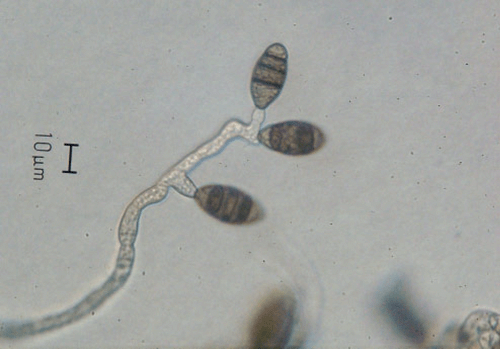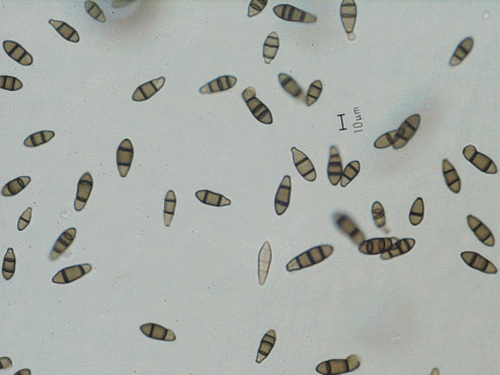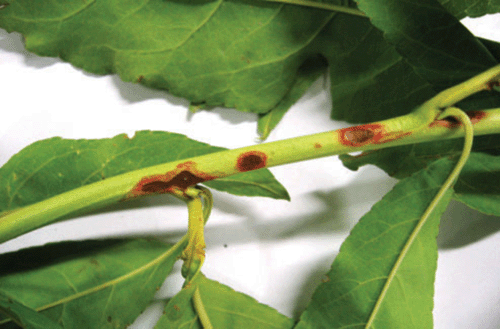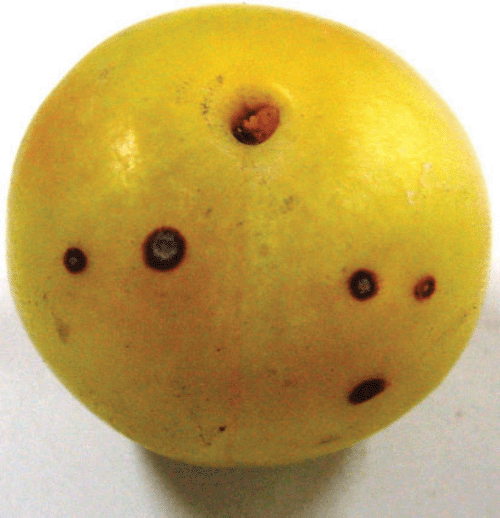Isolation and pathogenicity tests of Iranian cultures of the shot hole pathogen of Prunus species, Wilsonomyces carpophilus
A. Ahmadpour A , Y. Ghosta B , M. Javan-Nikkhah A C , R. Fatahi A and K. Ghazanfari AA Department of Plant Protection, College of Agriculture and Natural Resources, University of Tehran, Iran.
B Department of Plant Protection, Faculty of Agriculture, Urmia University, Iran.
C Corresponding author. Email: jnikkhah@ut.ac.ir
Australasian Plant Disease Notes 4(1) 133-134 https://doi.org/10.1071/DN09054
Submitted: 30 May 2009 Accepted: 30 November 2009 Published: 14 December 2009
Abstract
During spring and summer of 2007, 76 fungal isolates were recovered from different Prunus species in West Azerbaijan and Tehran provinces of Iran. Based on morphological characteristics, all isolates were identified as Wilsonomyces carpophilus. The occurrence of shot hole disease symptoms on almond, plum, peach and nectarine fruits, apricot twigs in orchards was observed. The first pathogenicity tests with W. carpophilus in Iran, using seven Prunus species, are reported.
Shot hole disease of stone fruit trees, caused by Wilsonomyces carpophilus (Lév.) Adaskaveg, Ogawa & Butler (= Stigmina carpophila (Lév.) M. B. Ellis and Coryneum beijerinckii Oud.) (Adaskaveg et al. 1990) is a serious disease of Prunus species in many parts of the temperate to semiarid regions of the world (Ogawa et al. 1995) as well as Iran (Ashkan and Asadi 1971). This disease is called shot hole because of the symptoms caused by fungus on the leaves of host trees. The disease was first reported from the northern region in Iran by Esfandiari (1947). The disease exists in most fruit-growing areas of Iran and is particularly destructive on apricot (Prunus armeniaca L.) in Azerbaijan province (Ashkan and Asadi 1971). Ashkan and Asadi (1971) isolated the fungus only from infected apricot fruits and observed symptoms similar to the shot hole disease on apricot, sweet cherry (Prunus avium L.) and sour cherry (Prunus cerasus L.) fruits, on almond (Prunus dulcis (Mill.) D. A. Webb.), peach (Prunus persica (L.) Batsch.), sweet cherry and sour cherry twigs and on leaves of different Prunus species. However, there have been no reports of the isolation of the causal agent of shot hole disease from other Prunus species in Iran, or pathogenicity tests.
During spring and summer of 2007, 76 monoconidial isolates were recovered from infected leaves, fruits and twigs of different Prunus species (apricot, almond, peach, nectarine (Prunus persica var. nectarina), plum (Prunus domestica L.), sweet cherry and sour cherry) in West Azerbaijan and Tehran provinces of Iran. All isolates were identified as Wilsonomyces carpophilus based on morphological and physiological characters and optimal temperatures for growth in culture (Adaskaveg et al. 1990). Hyphae were septate, thin-walled, branched, 2.5–7.5 μm in diameter, sub-hyaline to light brown. Conidiophores in the sporodochia were sympodial (Fig. 1), scars on conidiophores inconspicuous to conspicuous, conidia fusoid with apical cell ovate and basal cell truncate, 2.5–5 μm at the base, 2–4 transverse septa (occasionally 0–8 septa) (Fig. 2), holoblastic, rhexolytic, 20–67.5 × 7.5–15 μm, sub-hyaline to golden brown, dark olivaceous to black in mass. No growth was observed in culture below 5°C or above 30°C.

|

|
Twig lesions mostly 3–10 mm in diameter were observed on peach (Fig. 3), almond and apricot. Leaf and fruit lesions began as small purplish areas that expanded to brownish spots 3–10 mm in diameter. On fruits, lesions developed mostly on the upper side and eventually became corky and rough. Lesions were observed on the fruit of plum (Fig. 4), almond, apricot, peach and nectarine. Leaf lesions abscise in a warm and dry environment. Leaf symptoms were observed on different Prunus species (apricot, almond, peach, nectarine, plum, sweet cherry and sour cherry). The fungus infected and killed dormant buds. Dead buds were occasionally covered with a gummy exudate that gave them a varnished appearance. Infection of buds was observed on almond and peach (Fig. 3).

|

|
Stone fruit seedlings (apricot, almond, peach, nectarine, plum, sweet cherry and sour cherry) were used for pathogenecity tests in the greenhouse. Ten leaves and twigs from three seedlings of each Prunus species were sprayed with a conidial suspension (105 conidia/mL). Isolates used were KHG2, URH9 and KHJ1 collected from sweet cherry leaves (Khoy, West Azerbaijan), peach (Urmia, West Azerbaijan) and plum (Khoy, West Azerbaijan) fruits respectively. Inoculated seedlings were maintained at 20 ± 2°C and greater than 75% relative humidity (Grove 2002). Control plants were sprayed only with distilled water. Shot hole symptoms were reproduced on all inoculated plants. The symptoms were similar to those observed in the orchards and the fungus was recovered from all infected parts. Symptoms were not observed on control plants. This is the first report of successful pathogenicity tests with W. carpophilus in Iran. Ashkan and Asadi (1971) observed symptoms similar to the shot hole disease on leaves of apple (Malus domestica Borkh.) and pear (Pyrus communis L.) grown among the highly infected apricot trees in orchards, but they could not isolate the pathogen. We observed no symptoms of shot hole disease on apple and pear trees in orchards in our studies.
Acknowledgements
The authors would like to thank Dr Mina Rastgou from University of Urmia for her assistance.
Adaskaveg JE,
Ogawa JM, Butler EE
(1990) Morphology and ontogeny of conidia in Wilsonomyces carpophilus, gen. nov., and comb. nov., causal pathogen of shot hole disease of Prunus species. Mycotaxon 37, 275–290.

Ashkan M, Asadi P
(1971) Shot hole of stone fruits in Iran. Iranian Journal of Plant Pathology 7, 39–63.

Esfandiari E
(1947) Les maladies des plantes cultivées et des arbres fruitiers des régions subtropicales du nord de l’Iran. Entomologie et Phytopathologie Appliquées 5, 2.

Grove GG
(2002) Influence of temperature and wetness period on infection of cherry and peach foliage by Wilsonomyces carpophilus. Canadian Journal of Plant Pathology 24, 40–45.



